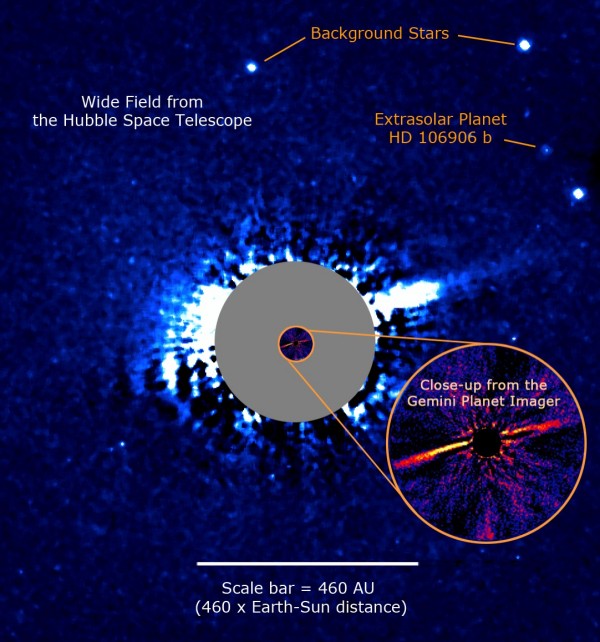This Planet Got Exiled From Its Solar System 16 Times Farther Than Pluto
| Ana Verayo | | Dec 02, 2015 07:10 AM EST |
(Photo : Paul Kalas/UC Berkeley) Two direct images of the cometary dust and exoplanet surrounding the young star HD 106906. The wider field in blue shows Hubble Space Telescope data where the star’s blinding light is artificially eclipsed (gray circular mask).
A planet that is located so far from its star, as much as 16 times farther than Pluto from the sun, is apparently kicked out from its original orbit near its parent star, that could also be similar to the early history of our solar system, according to a new study.
Observations and images taken from the Gemini Planet Imager located in Chile and the Hubble Space Telescope reveal that the star also possesses a lopsided comet belt, indicating a disturbing solar system, providing clues how planets were exiled from this system, forcing the comets closer to the star.
Like Us on Facebook
Scientists also believe that this exoplanet known as HD 106906 B, may have a ring of debris that was tailing behind it during its expulsion from its original orbit. According to astronomy professor Paul Kalas from the University of California, Berkeley, the planet itself could have attracted some material from this comet belt, surrounding itself with a large dust ring or shroud.
According to Abhi Rajan from the Arizona State University, measurements obtained from this planet also suggest that this planet possesses more dust than others, as the team is continuing to do follow up observations to confirm if the planet is indeed enshrouded by a disc.
These types of planets that are kicked out from their star system are helpful for scientists to gain more insight about the beginnings of our own solar system, since there could be planets that used to belong here other than the eight planets of today.
Kalas says that this could be a picture of our solar system some 13 million years ago, since this can be linked to our own comet belt which is the Kuiper Belt, which also lost this large mass during its evolution. In this new study, observations of young planets like this can provide clues how gravitational disturbances around young stars can kick out many cosmic objects including planets.
This new study is published in The Astrophysical Journal.
Tagsexiled planet, exoplanet, planet kicked out from its solar system, Hubble Space Telescope, exiled exoplanet, solar system, evolution of solar system
©2015 Chinatopix All rights reserved. Do not reproduce without permission
EDITOR'S PICKS
-

Did the Trump administration just announce plans for a trade war with ‘hostile’ China and Russia?
-

US Senate passes Taiwan travel bill slammed by China
-

As Yan Sihong’s family grieves, here are other Chinese students who went missing abroad. Some have never been found
-

Beijing blasts Western critics who ‘smear China’ with the term sharp power
-

China Envoy Seeks to Defuse Tensions With U.S. as a Trade War Brews
-

Singapore's Deputy PM Provides Bitcoin Vote of Confidence Amid China's Blanket Bans
-

China warns investors over risks in overseas virtual currency trading
-

Chinese government most trustworthy: survey
-

Kashima Antlers On Course For Back-To-Back Titles
MOST POPULAR
LATEST NEWS
Zhou Yongkang: China's Former Security Chief Sentenced to Life in Prison

China's former Chief of the Ministry of Public Security, Zhou Yongkang, has been given a life sentence after he was found guilty of abusing his office, bribery and deliberately ... Full Article
TRENDING STORY

China Pork Prices Expected to Stabilize As The Supplies Recover

Elephone P9000 Smartphone is now on Sale on Amazon India

There's a Big Chance Cliffhangers Won't Still Be Resolved When Grey's Anatomy Season 13 Returns

Supreme Court Ruled on Samsung vs Apple Dispute for Patent Infringement

Microsoft Surface Pro 5 Rumors and Release Date: What is the Latest?










